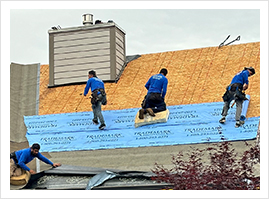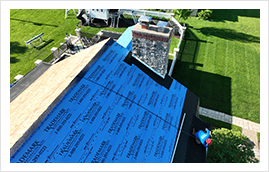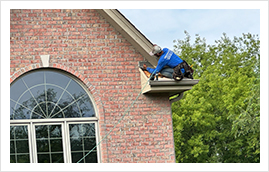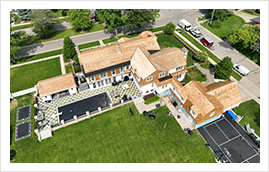Restoration Process

THE INSURANCE RESTORATION PROCESS
Disaster can strike twice if you don’t have the proper knowledge to deal with your insurance company. Follow the steps below to learn more about how Trademark Restoration Inc. can restore your home to its pre-storm condition.
No matter how well your home is constructed, your roof, gutters, siding and windows can all fall victim to Mother Nature’s fury. Every year, storm damage costs in the U.S. can add up to billions of dollars. Storms aren’t selective. If your neighbors are getting a new roof, siding, gutters or windows after the storm, chances are your home is damaged too.
STEP 1: PROPERTY INSPECTION
The first part of the claims process is an inspection of your property. A trained Trademark Field Supervisor will view the storm related areas and buildings to determine whether or not your claim needs to be filed. It isn’t as easy as it may sound–it takes training in this field to detect damage, some of which may be hidden. As a General Contractor and Exterior Specialist, we’re trained to know industry standards. There are certain criteria and guidelines set to follow that will determine if it is a replacement or a repair.
STEP 2: SUBJECT TO AGREEMENT
After inspection, your Trademark Field Supervisor will sit down and explain what repairs are needed to repair your home. The Field Supervisor will review all steps of the insurance restoration process and also explain the form that allows us to go to work for you, the homeowner. This form is called the “Subject To Agreement”. The Agreement states that you’re not under any obligation unless your claim is approved by the insurance company and they’re willing to pay for the repairs. The “Subject To Agreement” also states that the only cost to you is the insurance deductible. Trademark requires that we have this approval in writing before discussing the claim with an adjuster.

STEP 3: FILING THE CLAIM
Unfortunately, Trademark cannot file a claim for you. As the homeowner, you’re the only one that can file. But it’s not difficult–all that is required is for you to call your insurance company and let them know that your home has sustained storm damage. Once you have a claim number, we can assist from that point forward. While filing, you can also let them know you’re working with Trademark and that you would like their adjuster to meet with your Trademark Field Supervisor when they come out. This saves everyone time and the adjuster won’t need to make several trips, which helps us restore your home to its original condition as quickly as possible.
STEP 4: SCOPE OF WORK
Once your claim is filed, your Trademark Field Supervisor will return to your home and do a complete “scope of work”. By definition, a scope of work means a list of broken items and the measurements of the damaged areas. We don’t concern ourselves with pricing at this time. Our focus is on what’s most important; making sure you get all you’re entitled to receive. This generally takes about two hours. Some companies charge for this service at the average amount of 10% of your total claim. We never do. At Trademark, it’s part of earning the right to do your restoration work.
STEP 5: MEETING THE ADJUSTER
Your Trademark Field Supervisor will meet with the adjuster and point out all the damages that were found. The adjuster will create a breakdown as well. You’ll be comforted to know that both Trademark and the adjuster work from the same guidelines. The industry standards and criteria for assessing damage are actually set by HAAG Engineering in Carlton, Texas. When the insurance adjuster and your Trademark Field Supervisor are following the same guidelines, it’s easier to come to an agreement. Additionally, Trademark has experience working with all major insurance companies. Our Field Supervisors are trained to understand the language of insurance policies, which allows us to communicate well with the adjuster. When an accurate scope of work is confirmed by an adjuster and a Trademark Field Supervisor, the scope is placed into the software program, which generates a complete line-by-line itemized pricing for the project. Set standards and confirmation from both the insurance adjuster and your Trademark Field Supervisor gives the homeowner peace of mind knowing everything is accurate and everyone is in agreement.

STEP 6: FUNDING THE PROJECT
DEDUCTIBLE
Once we receive approval from your Insurance Company, two things will happen simultaneously. The Insurance Adjuster will tell your Insurance Company to write you a check for the Actual Cash Value for your claim. While you are waiting for your check, you and your Field Supervisor will pick out your building materials and colors. Also, our Field Supervisor will collect the insurance deductible check. This should be your only out-of-pocket expense.
MATERIAL DROP
We take all compiled information back to our office and prepare all work orders. At this time, Trademark’s production department will order the materials. Once materials have arrived on site, the Trademark Field Supervisor will inventory and confirm that the order is correct. At this time you will give the Field Supervisor the first check received from the insurance company. This amount is equal to the Actual Cash Value paid by the insurance company.
FINAL INVOICE
We will send the final invoice to the insurance company for the remaining funds. It generally takes two to four weeks for the final check to get back to you. All funds are sent to you, because it’s your claim. Due to length of time it takes for the final check to arrive, you’ll have plenty of time to make sure all is well and nothing was forgotten. At this time you give us the final check from the insurance company
STEP 7: PRE-CONSTRUCTION
Trademark understands that communication and customer satisfaction are essential, since it’s virtually impossible to have one without the other. Because we realize the importance of being prepared for the arrival of our crews, we’ll call the night before construction starts to inform you that the Project Manager and his crew will arrive in the morning. We’ll also remind you to review the How to Prepare for Construction checklist and to move autos to avoid being blocked in. The Field Supervisor and Project Manager will go over special attention areas such as existing leaks. Last, the Project Manager and Field Supervisor will inventory all materials, confirm your color choices and view areas for safety.
STEP 8: SITE PREPARATION
Upon arrival, the Project Manager will check in with you, and then the crew will prepare your home for safety and protection from damages. The Project Manager will also inform all of your neighboring home owners that construction is beginning and answer any of their concerns to put their minds at ease. A Trademark Field Supervisor will meet with our Trademark Project Manager at your home. From this point forward, all construction will be supervised by your Project Manager. During this meeting, we’ll address any special instructions or concerns you may have, such as landscape protection, decks, pools and personal property.

STEP 9: CONSTRUCTION BEGINS
Your Project Manager will organize the crew and point out the specifics of the job. The crew will provide protection for needed areas, such as tarps and plywood on the driveway and garage doors, etc. When performing multiple trade projects (roof, siding, gutters and windows), roofing is generally first. We literally work from the top down. Safety is our utmost concern; thousands of nails as well as many other sharp and potentially dangerous materials will be removed during this process
STEP 10: DURING CONSTRUCTION
The first step is to remove all of the old and damaged material, making every effort to keep a clean job site we generally strip the complete old roof before installing the new one, which is a very crucial step that allows us to do a deck inspection to insure that the nailing surface is solid. The second step is to install the new material. Different roofing systems have different underlayment. The top layer is the last step and generally takes a day or two. At the end of each day of construction, we will do a cleanup and after the last stage of construction, a final overall cleanup will be performed.

STEP 11: POST CONSTRUCTION
After the completion of each trade, your Trademark Project Manager will go over an inspection check list with you to make sure you’re completely satisfied with every aspect of our work. It is important that you complete an inspection with your Trademark Project Manager to make sure nothing has been overlooked and the restoration project meets your satisfaction and our high quality standards. This acts as a confirmation that Trademark has fulfilled our promise to you.
STEP 12: WARRANTY
After you receive your final check from the insurance company the Field Supervisor will collect the final balance due on the project. The Field Supervisor will turn the check in to our office and your final Workmanship Warranty will be sent to you. Our goal is to provide complete customer service from the initial inspection through the post-construction review.

 (800)293-0221
(800)293-0221